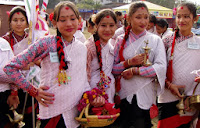 |
| People of Nepal - different communities |
 |
| Newar Community Ladies |
Nationality:
noun: Nepali (singular and plural)
adjective: Nepali
Ethnic groups:
Chhettri 15.5%, Brahman-Hill 12.5%, Magar 7%, Tharu 6.6%, Tamang 5.5%, Newar 5.4%, Muslim 4.2%, Kami 3.9%, Yadav 3.9%, other 32.7%, unspecified 2.8% (2001 census)
Languages:
Nepali (official) 47.8%, Maithali 12.1%, Bhojpuri 7.4%, Tharu (Dagaura/Rana) 5.8%, Tamang 5.1%, Newar 3.6%, Magar 3.3%, Awadhi 2.4%, other 10%, unspecified 2.5% (2001 census)
note: many in government and business also speak English (2001 est.)
Religions:
Hindu 80.6%, Buddhist 10.7%, Muslim 4.2%, Kirant 3.6%, other 0.9% (2001 census)
Population:
30,430,267 (July 2013 est.)
country comparison to the world: 41
Age structure:
0-14 years: 32.6% (male 5,045,989/female 4,859,274)
15-24 years: 22.6% (male 3,444,428/female 3,431,127)
25-54 years: 34.9% (male 5,015,145/female 5,593,248)
55-64 years: 5.5% (male 820,014/female 860,439)
65 years and over: 4.5% (male 630,853/female 729,750) (2013 est.)
Dependency ratios:
total dependency ratio: 66.1 %
youth dependency ratio: 57.6 %
elderly dependency ratio: 8.5 %
potential support ratio: 11.7 (2013)
Median age:
total: 22.4 years
male: 21.7 years
female: 23.2 years (2013 est.)
Population growth rate:
1.81% (2013 est.)
country comparison to the world: 66
Birth rate:
21.48 births/1,000 population (2013 est.)
country comparison to the world: 79
Death rate:
6.68 deaths/1,000 population (2013 est.)
country comparison to the world: 143
Net migration rate:
3.3 migrant(s)/1,000 population (2013 est.)
country comparison to the world: 31
Urbanization:
urban population: 17% of total population (2011)
rate of urbanization: 3.62% annual rate of change (2010-15 est.)
Major urban areas - population:
KATHMANDU (capital) 990,000 (2009)
Sex ratio:
at birth: 1.04 male(s)/female
0-14 years: 1.04 male(s)/female
15-24 years: 1 male(s)/female
25-54 years: 0.88 male(s)/female
55-64 years: 0.95 male(s)/female
65 years and over: 0.87 male(s)/female
total population: 0.96 male(s)/female (2013 est.)
Mother's mean age at first birth:
20.1
note: Median age at first birth among women 25-29 (2011 est.)
Maternal mortality rate:
170 deaths/100,000 live births (2010)
country comparison to the world: 61
Infant mortality rate:
total: 41.76 deaths/1,000 live births
country comparison to the world: 53
male: 41.8 deaths/1,000 live births
female: 41.71 deaths/1,000 live births (2013 est.)
Life expectancy at birth:
total population: 66.86 years
country comparison to the world: 165
male: 65.57 years
female: 68.19 years (2013 est.)
Total fertility rate:
2.36 children born/woman (2013 est.)
country comparison to the world: 93
Contraceptive prevalence rate:
49.7% (2011)
Health expenditures:
5.5% of GDP (2010)
country comparison to the world: 122
Physicians density:
0.21 physicians/1,000 population (2004)
Hospital bed density:
5 beds/1,000 population (2006)
Drinking water source:
improved:
urban: 93% of population
rural: 88% of population
total: 89% of population
unimproved:
urban: 7% of population
rural: 12% of population
total: 11% of population (2010 est.)
Sanitation facility access:
improved:
urban: 48% of population
rural: 27% of population
total: 31% of population
unimproved:
urban: 52% of population
rural: 73% of population
total: 69% of population (2010 est.)
HIV/AIDS - adult prevalence rate:
0.4% (2009 est.)
country comparison to the world: 72
HIV/AIDS - people living with HIV/AIDS:
64,000 (2009 est.)
country comparison to the world: 51
HIV/AIDS - deaths:
4,700 (2009 est.)
country comparison to the world: 39
Major infectious diseases:
degree of risk: high
food or waterborne diseases: bacterial diarrhea, hepatitis A and E, and typhoid fever
vectorborne disease: Japanese encephalitis, malaria, and dengue fever (2013)
Obesity - adult prevalence rate:
1.4% (2008)
country comparison to the world: 189
Children under the age of 5 years underweight:
29.1% (2011)
country comparison to the world: 18
Education expenditures:
4.7% of GDP (2010)
country comparison to the world: 86
Literacy:
definition: age 15 and over can read and write
total population: 57.4%
male: 71.1%
female: 46.7% (2011 est.)
School life expectancy (primary to tertiary education):
total: 9 years
male: 10 years
female: 8 years (2002)
Child labor - children ages 5-14:
total number: 2,467,549
percentage: 34 % (2008 est.)
(Source: www.cia.gov)
No comments:
Post a Comment